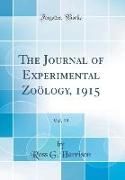- Start
- The Journal of Experimental Zoölogy, 1915, Vol. 19 (Classic Reprint)
The Journal of Experimental Zoölogy, 1915, Vol. 19 (Classic Reprint)
Angebote / Angebote:
Excerpt from The Journal of Experimental Zoölogy, 1915, Vol. 19Linkage has been explained by Morgan on a chromosome basis, in accordance with the cytological evidence. It is assumed that gens occupy fixed positions, linearly arranged within the chromosome. In diploid groups each such linear series is represented by two homologous chromosomes, A and a, every locus in the one (a) corresponding to the same locus in its homologue (a). Before maturation homologous chromosomes become paired, side by side, and the members of each pair be come twisted about each other. At some of the points of con tact the two strands twist in two, as it were, moreover, the end of A fuses to the other end of a. As they lie opposed. Any gens that were in strand A but on different sides of a chiasma point will emerge in different strands because of the crossing - over, and hence will be segregated to different gametes. It is obvious that the closer together in the strand any two given gens lie, the less is the chance that in any given maturation a chiasma will occur between them, the chiasmas being distributed ao cording to chance. The basis of linkage is that two gens lie in the same chromosome so close together that in less than half the maturing germ cells a crossing-over takes place between them.About the PublisherForgotten Books publishes hundreds of thousands of rare and classic books. Find more at www.forgottenbooks.comThis book is a reproduction of an important historical work. Forgotten Books uses state-of-the-art technology to digitally reconstruct the work, preserving the original format whilst repairing imperfections present in the aged copy. In rare cases, an imperfection in the original, such as a blemish or missing page, may be replicated in our edition. We do, however, repair the vast majority of imperfections successfully, any imperfections that remain are intentionally left to preserve the state of such historical works.
Folgt in ca. 10 Arbeitstagen


